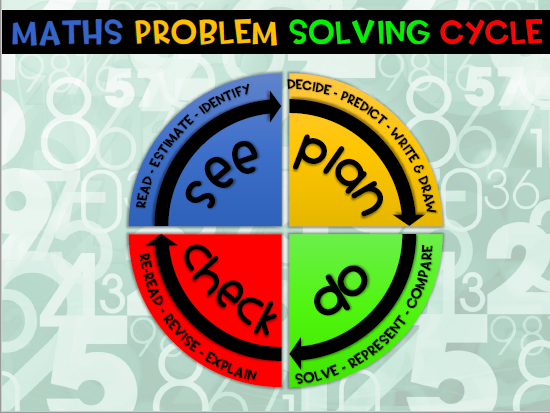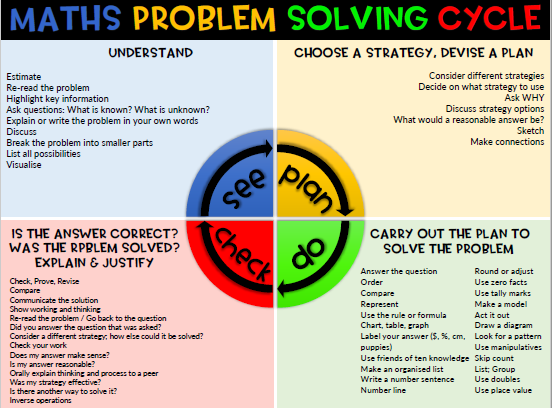Mathematics at Larrakeyah Primary School
In late 2017 the Principal and Leadership Team created a School Improvement Plan (SIP) for 2018 – 2021 . The SIP establishes priorities for Larrakeyah School in a number of Focus areas and looks at:
- what would be delivered within the Focus areas.
- how to monitor progress towards the focuses.
- what the baseline data in 2018 was and what our targets for 2021 would be.
The subject of Mathematics was identified as a major focus, along with Writing and Data. Today, let's take a look at Mathematics at Larrakeyah Primary School:
- how teachers program mathematics.
- how mathematics is taught.
- what a typical lesson structure looks like.
- what resources are used.
- how data is used to improve the teaching of mathematics and the learning outcomes of students.
Mathematics must be a priority of Larrakeyah Primary School to ensure that students entering schooling today are capable and successful in the workforce of 2030 and beyond. The Trends in International Mathematics and Science Study (2015) indicated that Australian students were lagging behind other nations. For example:
- In science, the TIMSS average score of Australian students fell between 2007 and 2011.
- In mathematics, the TIMSS average score of Australian students remained level.
However, across both science and mathematics, the number of other countries outperforming Australian students rose significantly between 2007 and 2011. In 2007, the number of countries outperforming Australia rose from 12 in 2007 to 17 in 2011.
The Office of the Chief Scientist summarised the importance of transforming STEM teaching in Australian primary schools.
Key initiatives have since been undertaken to transform STEAM education in primary schools, with emphasis placed on supporting and developing teachers and learning programs. The Larrakeyah School Improvement Plan furthers these developments to achieve strong outcomes in mathematics as part of our wider STEAM focus.
Planning for Mathematics
Larrakeyah Primary teachers are required to plan lessons using the Australian Curriculum for Mathematics and are required to create a yearly overview that states what topics will be covered each week throughout the year. Teachers are free to sequence the topics in the way they would like, while remembering that they need to report on each of the 3 strands each semester (Number and Algebra, Measurement and Geometry and Data and Statistics). Topics are obtained from the content descriptors from the Australian Curriculum. To ensure there is consistency among the grades, Year Levels must follow the same topic sequence. A minimum of one hour of Mathematics is taught daily. In their Mathematics program specific teaching strategies are clearly articulated and these strategies are linked to how the content is differentiated for different groups of learners.
Teachers must also allow for a problem solving Mathematics lesson once a week in their program. This session is where students practise the 4Cs (collaboration, communication, critical thinking and creativity) to solve a problem based on the concept they have been learning about. Larrakeyah Primary School is also a Visible Learning School which means all explicit lessons of Mathematics must have a Learning Intention and Success Criteria.
Mathematics Teaching Model
Larrakeyah Primary School has a Mathematics teaching model that helps to streamline teaching across the school. The content and pedagogy within the model is up to the individual teacher. Concrete materials and the practical application of Mathematics skills are at the heart of our philosophy. Students should experience Mathematics in a real context and work to improve their understanding, fluency, problem-solving and reasoning skills.
The Four Proficiencies of Mathematics
- Understanding; knowing why
- Fluency; knowing how
- Problem Solving; finding out how
- Reasoning; finding out why
A topic is established and taught, building through the stages of learning from understanding to reasoning, or from a concrete level of thinking through to an abstract idea or concept. Depending on the nature of the topic/concept, the teaching time required may need to be extended or reduced to suit the class and the needs of the students.
This model is a generic guideline that can be adapted by individual teachers to suit their teaching context and their individual classrooms. For example Early Childhood classes may include increased time in the Group Activities and hands-on practice parts of the model as repeated experience is required. Similarly more explicit teaching in Upper Primary may be required as concepts increase in difficulty.
During each hour session the lesson is broken into 4\5 parts:
- Warm Up
- Tuning In
- Explicit Teaching
- Group Activities/Individual Practise or Hands on Experiences
- Reflection
The lesson progression also moves from a lower level of thinking to a higher level depending on the needs of our students and the concept being covered.
The Lesson Structure Model
Warm up - 15 minutes to start
Goal: to build fluency with basic number facts, mental arithmetic, timetables, Maths Mentals
Resources: New Wave Maths Mentals, Multiplication Facts revision (Speed Maths, 100 club, etc.)
Tune in - 5 minutes
Goal: Go over the Learning Intention, and
Success Criteria: to make students aware of what they are learning and how they will know they have been successful.
Explicit Teaching - 15 minutes
Goal: Whole class teaching of the concepts – introduced at the beginning of the week and, as the week progresses, this time is spent extending students, explaining misunderstandings, deepening the fluency and exemplifying the concept in a practical context. Teachers can use an enVisionMATHS introductory video or Visual Learning Bridge at the start of a topic. Concrete materials must be used during explicit teaching.
Individual Practice/Group Activities/Hands on Experience - 20 minutes
Goal: Students experimenting, undertaking exploration or a task that involves practical application. When introducing a concept this should form a large part of the lesson. These experiences help students develop knowledge, understanding and confidence with a skill or concept. They are then able to move to a written and eventually mental level of understanding.
Resources: The Mathematics Store (Compactors in the Teacher Resource Room) or the enVisionMATHS Activity zone.
Reflection on Learning - 5 minutes
Goal: Students reflect on the learning that took place throughout the lesson this may be done using an exit pass, going over success criteria, self-reflection tool, by providing feedback, peer feedback.
Since our primary question should be “What do I want my students to understand?” instead of “What do I want my students to do?” it is problematic when teachers have a prescribed activity in mind—a standard algorithm—and unthinkingly reject creative problem solving when it doesn’t conform to convention or prescription. In cases where students' actions are unconventional, but legitimate, and are rejected by a teacher, students learn once more that “to understand” means to memorize a prescribed activity.
Problem Solving Tasks
Larrakeyah Primary School Teachers are expected to plan a problem solving task at least once a week for the students in their class. The task should allow for differentiation, and be based on the concept being taught in class that week. This means students are applying the knowledge learnt throughout the week to an actual problem. Teachers need to ensure that the right problem is selected to not only challenge the students in the class but also allow them to feel successful. Students are encouraged to work with their peers and teachers are strategic with the groupings of their students.
Larrakeyah Primary School has also implemented the Problem Solving Cycle with the aim in mind to build consistent language across the school. Teachers are able to use this cycle whenever they wish, and must refer to it during the assigned problem solving day. The posters must be on display in the classroom and referred to.


Mathematics Supplementary Teaching Resources
The following resources are used extensively by teachers in their teaching of mathematics.
Cambridge Primary Maths
Cambridge Primary Maths is an innovative combination of curriculum and resources that supports teachers and learners through best-practice international Maths teaching and has a problem-solving approach. The textbooks from Cambridge University Press provide the best-in-class support for this problem-solving approach, based on pedagogical practice found in successful schools across the world. These resources have been purchased by the school. The engaging NRICH online resources help to develop mathematical thinking and problem-solving skills.
enVisionMATHS
enVisionMATHS is a topic-driven teaching and learning program aligned with the Australian Curriculum: Mathematics content and proficiency strands. This is a Transition – Year 6 series with extensive print and digital topic-based components. Differentiated teaching and learning strategies allow teachers to tailor their methods to reach every student, giving them the opportunity to succeed and improve. The comprehensive, flexible topic-based components allow teachers choice in how they teach each topic. The teacher resources include access to enVisionMATHS online, Teacher Resource Box, Teacher IWB CD rom, Activity Zone Box, Student Activity Book & the student Thinking Skills Book. All teachers are provided with these resources for their class/year level/s.
Mathletics
Mathletics is designed to support teachers to deliver lessons in their own time and way. It is an online Mathematics resource where all students from Transition to Year 6 have their own log in. Teachers set tasks that relate to the concept/topic they are teaching. These tasks can be done during school hours or at home.
Mathseeds
Mathseeds is an online math program specifically designed for students in Transition – Year 2. There are many interactive activities, catchy songs and the program covers all mathematical concepts. Students have their own log in details and can complete activities at home or at school.
Other resources may be required to supplement gaps or topics that require revision or extension include:
- Maths Plus Student Textbooks (Year 2-6) and Interactive Digital Lessons (Year 3-6)
- Targeting Maths
- Count Me In Too (Early Childhood)
- Understanding Maths (Upper Primary Year 5&6 )
- Nelson Maths (Early Childhood)
- New Wave Mentals (Upper Primary)
Assessment
Assessment is carried out throughout the teaching and learning cycle and includes
- Diagnostic
- Formative
- Summative
- Standardised Assessments
Individual teachers complete and keep records of student achievement. The four proficiencies of Mathematics and the Australian Curriculum Support Documentation help teachers to plan assessments that are meaningful and allow students to demonstrate their learning and mathematical thinking. This may include Rich Tasks or open ended problems that focus on Higher Order thinking and reasoning skills.
Every semester teachers are required to collect data on individual students to inform their teaching and reporting. The standardised test for Year 1 to Year 6 students is PAT-M. The results from testing informs planning and differentiation for the teaching of Mathematics. The data from the test allows teachers to focus on skills students are weakest at. The teacher’s use of data is also reflected in their teaching program. They need to show how they use the standardised testing data to inform their planning and what ongoing evaluation is happening to continuously inform differentiation.
Teachers are required to complete Pre and Post tests for the concepts covered throughout the year. Data collected from the Pre Test helps teachers determine areas to focus on while they cover the unit. The Post test is to ensure that improvement has been made after the teaching has taken place. All students within a year level should be completing the same assessments.
Mathematics Triad
Teachers at Larrakeyah Primary School also participate in a Triad Program. Triads are a group of three teachers who work with each other for the purpose of observing lessons and giving and receiving feedback. While observing teachers use a triad template, outlining the instructional model and other expectations of Larrakeyah Primary School. Triads are designed to be a positive professional development opportunity.

